Why Sales and Marketing Belong in One Bucket — Not Two
- sami ali
- Jul 22
- 3 min read

Most businesses divide their operations into three main buckets: marketing, sales, and fulfillment. It sounds organized on paper, but in practice, this separation creates a serious problem. Sales and marketing are deeply connected. Splitting them into two separate silos causes disconnect, misalignment, and ultimately, lost revenue.
Let’s break it down.
Sales and Marketing Go Hand in Hand
Marketing generates leads. Sales closes them. Simple, right? Not quite.
Your sales team is on the front lines. They talk to real people every day. They know which leads are serious and which ones are just browsing. They know the objections, the questions, the hesitation points. That is gold for a marketing team.
But when sales and marketing operate in different lanes, the feedback loop breaks. Marketers keep running ads that bring in bad leads. Sales reps burn out trying to turn junk into gold. Or worse, you blame your closers for not converting cold traffic that was never a fit to begin with.
On the flip side, if your marketing is attracting solid leads and your sales team still can’t close, the issue isn’t lead quality. It’s sales execution. These two departments need to be in constant conversation. Without that feedback loop, you are guessing instead of optimizing.
Why Fulfillment Stands Alone
Fulfillment is different. It is the delivery engine. Whether you are a coach, an agency, or a product-based brand, fulfillment is what happens after the sale. You create results, deliver value, and keep your promises.
You can be world-class at fulfillment, but if your sales and marketing are not aligned, your pipeline will suffer. No leads means no customers. No conversions means no revenue to fulfill. Fulfillment deserves its own focus because it operates after the sale and serves a different function entirely.
Business Owners Get It Wrong — Even When They Know Better
Here is the ironic part. Many business owners are incredible at both sales and fulfillment. They love their product. They know how to talk about it. They close deals because they are passionate and knowledgeable.
But when it comes to scaling, they outsource sales or marketing or both. And instead of building alignment, they create distance. They stop listening to the sales team. They ignore feedback about lead quality. They chase attribution reports instead of conversations.
That is how great reps quit. They are handed bad leads and told to “just close better.” Or they are given great leads but lack the tools and training to convert them. Either way, they burn out. And you are back to square one.
The Fix: Merge Sale and Marketing Into One Aligned Engine
Sales and marketing should not be separate silos. They should be one aligned function that shares goals, data, and wins. Marketing brings in the right people. Sales closes them. Then marketing takes the lessons learned from those conversations and improves the targeting. Over and over again.
That’s how you create scalable growth. That’s how you make sure every dollar spent on ads turns into revenue. And that’s how you build a team that stays, performs, and grows with your business.
Final Thoughts
If you are great at fulfillment and sales already, the next step is not outsourcing your sales pipeline. It is aligning your sales and marketing so they work together as one. Keep fulfillment in its own bucket where it belongs. But merge your lead generation and closing into a single, responsive feedback loop.
That shift is what separates scattered startups from stable businesses that scale.


댓글